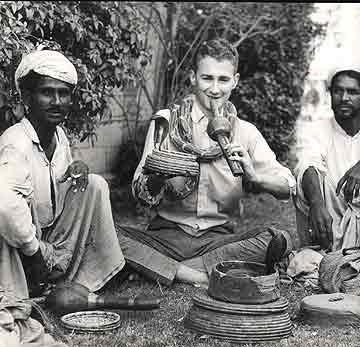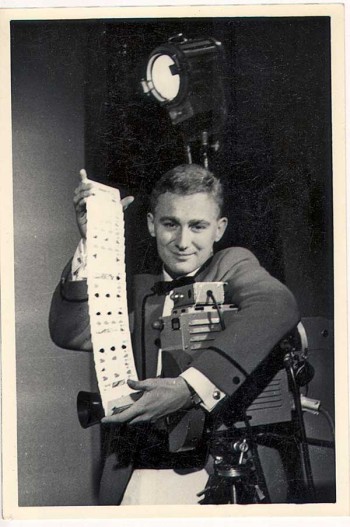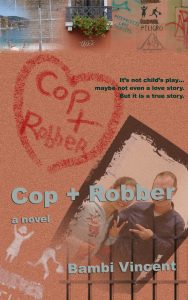
At the fork in the road I went left.
I can thank the Parsis for my passion for photojournalism.
Another man might have turned away, but when I saw a vulture picking the limbs of a dead child, I raised my camera. Perhaps that says more about me than I should reveal.
Instead of burning their dead and feeding the ashes to the River Ganges as Hindus do, Parsis lay the bodies of their dead on a grid suspended over a high tower. To attract vultures to the burial tower, corpses are smeared with rancid animal fat. The scavenger birds pick away the flesh and the cleaned bones then fall onto the earth, lime, and charcoal floor of the tower to decompose into the soil. How I came to witness this alien rite was through the same set of circumstances that so profoundly impacted my career.
At twenty I hadn’t yet decided whether to become an entertainer or a photographer. My true passion was travel, and the more off-beat and distant the destination, the better. To fund my expeditions, I took engagements as a performer for four to six weeks in faraway countries, and at the end of the gigs I would trek into surrounding villages and countryside.
Performing in the Far East in the sixties gave me a unique opportunity to visit cities that I otherwise would never have had a chance to visit for such extended periods. While my craving for photojournalistic excitement was supported by my show income, I made an effort to meet local authorities and make the right contacts intending to pursue photojournalism with a bent toward the absurd.
Bob Arno’s path to pickpocketing
Even way back then my show was unusual—pickpocketing had never been seen as entertainment. It was my ticket to the exotic destinations most people only dream of. And on my journeys I witnessed, sometimes inadvertently, headline news. Neither ordinary tourists nor visiting journalists could have had such easy access to behind-the-scenes briefings. For I was tied to the U.S. Military.

I had always had a strange desire to capture macabre images with a camera. It started as a hobby, then became a semi-profession during my first journey to Asia. In 1961 I toured Pakistan, India, Thailand, Malaysia, Laos, Vietnam, Hong Kong, and Japan as an inexperienced entertainer. I augmented my performance salary by taking freelance photography assignments in locations where Western photographers were still a bit of a rarity.
The world was hungry for unusual stories from Asia then. As a young and raw journalist with little comprehension of the underlying political issues of the area, I came face to face with the dramatic events of the day. Being in the right place at the right time was at the heart of my earliest photojournalistic adventures.
With the beginning of the war in Vietnam, U.S. forces were building steadily in the Far East. These were the darkest years of the Cold War and the fear was of China’s involvement in the Indo-Chinese conflict. Everyone was concerned about the war escalating and spilling over into the Philippines, Thailand, and Korea. The large U.S. bases in the Philippines, Taiwan, Thailand, Okinawa, and Japan all needed entertainment for the troops.
Most of my performance engagements then were for these American soldiers. My comedy pickpocketing was new and different and audience participation was always a hit. I had long contracts on the military bases, as well as in the civilian clubs—camouflaged girlie-joints, really—which attracted the soldiers. It was this environment which fueled my taste for absurd and offbeat news stories.
Photographers in those early years of the conflict hung out together in the hotel bars of Saigon. That’s how I met Larry Burrows, a British war-journalist who worked for Life magazine and was one of the most-awarded photographers to come out of the Vietnam war. Burrows helped me gain contacts in Saigon, both with the American military command and with the opposing factors. Without leads and the contacts you wouldn’t get “the story.”
It was because of Larry Burrows that I was one of only five photographers in Saigon who were privy to the intelligence-leak that a monk was about to commit suicide. An immolation was to occur in the early hours of June 11, 1963, at a compound outside Saigon in front of a few select journalists. The Bhuddist leaders orchestrating the sacrifice schemed that the global reaction to the front-page photos of the monk setting himself on fire would create an anti-war movement. The goal was to speed up peace negotiations.
At three in the morning, we photographers were rushed from the hotel out to the compound. The unlucky monk who had been selected for the sacrifice had already been drugged into a semi-comatose state and sat on the ground. As soon as the media were ready with their cameras, other monks poured petrol over the “victim,” and he was then set alight. We let our Nikon motordrives spin throughout the ordeal and the resulting pictures, mine included, created enormous impact and news coverage in all major newspapers around the world.
[EDIT 1/2/13: See comments below for Bob Arno’s elucidation on this experience.]
My first photo essay was from Pakistan where I shot the story on the Parsis and their infamous Towers of Silence. Their disposal of the dead isn’t so gruesome when you understand their belief in preserving the purity of fire, water, earth, and air. So as not to pollute these elements, they will not burn, bury, or sink their dead. Still, mine were morbid photos by an immature photographer. It wasn’t the historical perspective of the burial rituals which sold the story, but the stark and grisly images of vultures ripping limbs from human corpses.
In similar stark but shallow style, I photographed Hindu cremations at the burning ghats in Benares on the Ganges River, morning bathing rituals in the Ganges in Calcutta, opium dens in northern Thailand, the Bridge at River Kwaii, faith healers in the Philippines, and leper colonies in India.
One particular photo project had a strong impact on my career path. The story was on beggars and pickpockets accosting foreign visitors in Karachi. This was my introduction to a cynical distraction method based on sympathy and compassion. The pickpockets were lepers, and they were exploiting pity for profit.
In the early sixties leprosy was still a serious threat to the populations of India and Pakistan. It was common to see sufferers in various stages of deterioration roaming the streets of Karachi, Calcutta, Bombay, and New Delhi. Banding together, they often surrounded Western visitors coming out of banks, hotels, and churches. The sight of an outstretched hand with missing or rotting fingers usually caused people to react with horror and drop some coins, if for no other reason to get the infected limbs to go away. Compassion and revulsion metamorphosed into currency. The ploy was effective, diabolical, and unique to Pakistan and the Indian subcontinent.
My story showed a team of lepers who specialized in pickpocketing under the guise of begging. While one tugged at the left side of the mark and held out his diseased hand for baksheesh, his accomplice on the mark’s right fanned—softly felt for the wallet. When the victim looked left, aghast at the touch of such ravaged hands, his reaction would be a sudden jerk to the right to get away from the loathsome encounter. The partner on the right would lift his wallet in that moment of abrupt contact.
This was the most primitive of survival instincts, where rules of civility, shame, and respect didn’t apply. Just raw confrontation between the haves and the have-nots. I was only 22 years old when I first witnessed this subterfuge, and I was both stunned and fascinated. Stunned at the callousness of using the primeval emotion, fear, to accomplish distraction. Fascinated by the realization that there were people so desperate they would go to any extent to find money to survive for the next couple of days. It was a rude awakening for a youth raised in the privileged shelter of socialist Sweden.
Watching this base encounter is what inspired my lifelong effort to document, and to unravel, the mind-games which nearly always attend pickpocketing. I was intrigued by the fact that wit was as much a part of it as was technique. This is what challenged me to explore the criminal mind. Pickpocketing is not an activity that one only practices now and then. It’s a daily routine performed several times in a fairly short time span. It’s an intense crime based on dexterity and, equally important, on psychological analysis of the opponent. A good pickpocket must be able to read many signals and make an instant decision on whether to go for the poke or wait for a better opportunity.
I was also intrigued, in those early years, by the cleverness of the set-up. Although the theatrical theft of a wallet on stage is entirely different from lifting one in the street, the principles of distraction are the same. By studying the real thieves, I realized I could incorporate their techniques into my performance. I began a fanatical collection of stratagems, always on the lookout for the clever, devious, cunning, slick, duplicitous, ingenious, innovative, inventive, and creative new trick.
Much later in my career, exactly thirty years later, I would find that the lepers’ technique—begging on one side of a victim, pickpocketing on the other—was nearly identical to the methods used by thieving gangs in southern Europe today.
Another pivotal moment arrived for me that same year in India when I realized that gangs of beggars and pickpockets usually worked under controlling leaders. Not protectors or father-figures to homeless children, these leaders were brutal mutilators who intentionally crippled children in order to make them better beggars, allotted them territories, and demanded daily payments from them. My discovery of this grim reality was the spark that fired my quest to find, understand, and expose the manipulators’ deception.
From Indian beggars to east European gypsy families to American inner-city street toughs to North African pickpockets to Colombian tricksters, I have always asked this question: how did you learn your trade? Was it passed down within the family? Was it learned in prison? Was destitution the motivator?
For more than forty years a rumor has been whispered among police forces in America that an organized school for pickpockets exists. The School of the Seven Bells is said to graduate a certified pickpocket when he can steal from all the pockets of a man’s suit while it hangs on a mannequin, without ringing little warning bells tied to the clothes. A pickpocket in Cartegena told us that the school is nestled high in the mountains of Colombia. An American cop told us of a variation in Chicago, in which razor blades buried in the suit pockets replace the bells. And yet I have never spoken to a policeman who has succeeded in getting any detail from detained pickpockets about the school. Perhaps it is mere myth. My search continues.
One of the most common questions people ask me after they’ve seen my lecture or one of our documentaries on con games is how I got so interested in tracking criminals. The easy answer is that one thing led to another: stage pickpocketing to observing street thieves to adapting their tricks for the stage. But that denies the force of my own personality in steering my expedition through life. It’s far more difficult to define the eccentric quirk in my psyche that attracted me to deceit, deception, and double-dealing—but always on the right side of law and morality. I am fascinated by confidence games and have the great fortune to enjoy my interest as my career.
In my younger years, my trio of passions—travel, photography, and entertaining—seemed to be in conflict; I thought an inevitable choice would have to be made. Maybe I never grew up. I still travel the world non-stop and I still love it. I’m still deeply involved in photography, though it has mostly evolved into videography. And I am still a full-time entertainer working theaters and private corporate events around the world. I’m having a blast. How lucky can one man be?
Excerpt from Travel Advisory: How to Avoid Thefts, Cons, and Street Scams
Chapter One (part-l): High and Dry on the Streets of Elsewhere







12 Comments
Thanks for your compliments, Aspsusa! You’ll be happy to know that Bob IS working on a biography. Slowly… but steadily. Your suggestions are good and will probably influence him!
Your site is so intriguing – I’ve spent most of the day reading in all the various categories here (when I should have been out shopping for a new phone and doing other chores).
Bob, you really should write a book about your years as a photographer in Asia and Africa. The fact that you gave it up gives you a unique POV (and you write well, too). The story of how conflicts, poverty and “the other” has been told in images is important, and you were there when news started to become ever more image-dominated.
Your subsequent and present work is interesting (and Bambi’s curating of this site is top notch!), but what you witnessed then, how you thought about it then, and how you think about it could be the basis for a very valuable book.
[…] Clever strategist pickpockets tap directly into their victims’ emotions, the hard-wired ick factor being a useful one. Bob Arno described how, as a youth, he was “stunned at the callousness of using the primeval emotion, fear, to accomplish distraction”: […]
I stumbled across this article while researching the art pickpocketing, and what a find! Absolutely vivid, i couldn’t stop reading until the end. I envy you, sir. Makes me feel like i need to start actually living.
It’s not very often that I reply to a comment on the many sites where we have a presence. The majority of comments do not require my input, or would simply create more controversial or emotional reactions.
But in the case of the “burning monk” photo, a reader needs to understand the environment where this took place; war-torn Vietnam in the early sixties before the Vietnam war had really commenced, and when it was still a possibility for a negotiated peace between the three factions.
I was placed into this unique position, witnessing the immolation, as a very young and inexperienced photographer, because of my mentor at the time. The much admired TimeLife photographer Larry Burrows, far more experienced, capable, and entrenched into the politics of Vietnam. It was Larry who brought me to this location, on the outskirts of Saigon, but it should also be understood that this was a manipulated scene with an agenda. The Buddhist faction and in particular this group, created the sacrifice of one Buddhist (as a way of drawing attention to their cause). It was NOT a random expression of one or two Buddhists who were seeking peace in their own way of demonstration. I can write a long chapter on the ugliness of this agenda, or the particular details surrounding the actual immolation, but I am sure that there are other far more experienced news photographers who can discuss the pros and the cons of reporting war atrocities in various forms.
If this becomes an issue that is interesting to others in addition to Rob, I will be happy to write more details, and to point to links with great depth on the moral challenge of war reporter who faces atrocities. What I have learned after participating in this “game” (and I call it a game because there is usually a puppet-manipulator pulling the strings of news media) for more than fifty years now, is that ALL reporting is based on agendas and POVs. There is very little truly honest reporting or commenting. By 1975, I gave up on photography after a long spell on the African continent where I witnessed far uglier scenes than what I saw in Vietnam.
I will go as far as saying that nearly seventy-five percent of all media reporting lacks impartiality and honesty, especially today when so much reporting is distributed free and dependent on advertising in some shape or form.
I am today faced with similar moral dilemmas in filming “crime in action.” But today I have MY OWN agenda am not pressured by outside businesses or corporations. I can afford a certain amount of independence. Unfortunately, because of my present work (in the field) I cannot reveal the goals or the actual effects my public persona has on crime prevention. In due time I am sure I can discuss these complex issues.
For the time being, let me summarize: no journalist steps into the action or takes sides (except with some very rare exceptions).
You’re right, Rob. In retrospect, Bob is repulsed by that incident from back when he was an immature 23-year-old at the beginning of his career and new to the greater world. On the other hand, journalists exist to report on events, not stop them. In this story, Bob reveals some of his early influences—whether or not he is proud of them—to illustrate his off-beat interest.
You brag about photographing a monk being set on fire. It’s depressing that you photographed it instead of stopping the monk who “…had already been drugged into a semi-comatose state…” from burning to death. Your story isn’t interesting, it just shows the sad state you’ll turn to in order to sell a picture.
good read
[…] often ask myself why I’m so intrigued by the behavior and thinking process of smart con men (versus unsophisticated street criminals). Are the Madoffs of the world more clever than the rest […]
Absolutely fascinating. A one of a kind life!
Ask Rick to define Herregud.
AMAZING GREAT POST !!!!!!!!!!!!!!!!!!
Uh – wow. Herregud. Speechless.